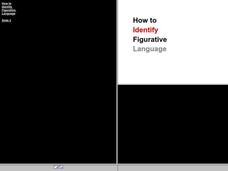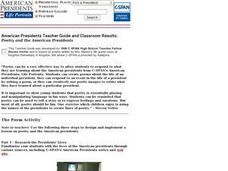Curated OER
Writing a poem
High schoolers imagine themselves someplace -- the beach, a mountain top, a city street -- anywhere.
Curated OER
It's All Poetry to Me!
Fourth graders explore language arts by analyzing poetry styles. In this writing analysis lesson, 4th graders read several sample poems in class and identify similes, metaphors and other figurative language within them. Students analyze...
Curated OER
How To Identify Figurative Language
Students investigate writing techniques by analyzing a chart. In this figurative language lesson, students define similes, metaphors and identify the difference between them and personification. Students demonstrate their understanding...
Curated OER
Spring Similes
Students write similes with a partner. In this spring similes lesson plan, students discuss the season an write a story using a minimum number of similes.
Curated OER
Figurative Language-Part 1
Pupils explore figurative language. In this figurative language lesson, students look up, define, and give examples of a list of literary terms.
Curated OER
Identifying Figurative Language
Students explore Fahrenheit 451 by Ray Bradbury. In this figurative language lesson, students locate similes, metaphors, and examples of personification in their reading. Students write down the page numbers of each example for future...
Curated OER
A Simile and Metaphor Lesson
Students use their knowledge of similes and metaphors to analyze poetry. In this poetry and language lesson plan, students read examples of similes and metaphors and write their own examples that describe their city, television, or an...
Curated OER
Dog With Personified Newspaper in Mouth (Coloring)
In this coloring instructional activity, 2nd graders are given a line drawing of a silly dog with a newspaper in its mouth. The newspaper has eyes and hands; the instructional activity can be used as a prompt for an essay on...
Curated OER
Looking At the World Through Different Eyes
Students are introduced to the concept of reframing as a problem-solving alternative. They present the value of incorporating adults into their suport system. Students draw what they think Creep Face and Maggie saw when they looked...
Curated OER
No Title
Fourth graders, after brainstorming a list of things good friends do for each other, apply prereading strategies to the book, "Be A Friend to Trees," and create similes and metaphors utilizing content ideas. They also sketch an...
Curated OER
Journeys to Self Discovery
Pupils explore both physical and mental journies that result in a change or self-discovery. They write poems that symbolize a personal journey that forever changed them. They understand the importance of a central image or metaphor in a...
Curated OER
Doors to Knowledge
Students identify symbols on a pylon and explain why the names of the Great TEachers the symbols represent. They interpret what religion is to them and sing a song about religion lead by the teacher. Finally, students construct a...
Curated OER
Dumbing Down
Students explore the definition and derivation of the popular saying "dumb down." Using worksheets and lecture materials, students provide meanings for the phrase when used in varying contexts. They also consider the derivation of each...
Curated OER
Street Cred
Students explore the definition and derivation of the popular word "cred." Using worksheets and lecture materials, students provide meanings for the word when used in varying contexts and when used as a phrase. They also consider the...
Curated OER
Keeping Your English Up To Date: Bless
Students explore the definition and derivation of the popular usage of the word bless to talk about sweet or cute things. Using worksheets and lecture materials, students provide meanings for the word "bless" when used in varying contexts.
Curated OER
Bling and Sound-Symbolic Words
Students explore the definition and derivation of the popular term "bling" and other sound-symbolic words. Using worksheets and lecture materials, students provide meanings for the word "bling" when used in varying contexts. They...
Curated OER
Poems in Sections: The Mosaic Format
Students explore poetry. They examine metaphors. Students discuss and write examples of "figurative" and "literal" language. They read mosaic poetry. Students write a poem in mosaic format.
Curated OER
Similes and Metaphors
Students explore similes and metaphors. They discuss and define similes and metaphors, identify the similes and metaphors in two poems, and create three original examples of each.
Curated OER
Poetry and the American Presidents
Fifth graders choose a poetry activity in order to focus their research about American presidents.
Curated OER
Movie Metaphors of Canadian Prime Ministers
Students research the life and public service record of various prime ministers and assign a movie title to each prime minister. Groups must agree on the movie assigned to each PM, and explain their reasoning for choice.
Curated OER
What's the Deal With Nature?
Twelfth graders read the poem "Crossing the Swamp" and "Pipefish" then discuss the use of metaphor in each poem. They write a poem about how they feel about school using a nature metaphor.
Curated OER
Comments WERD
Students examine several examples of similes and metaphors, stating what is being compared. Then each student chooses a different person from the Civil War era and writes similes and metaphors that describe that person.























